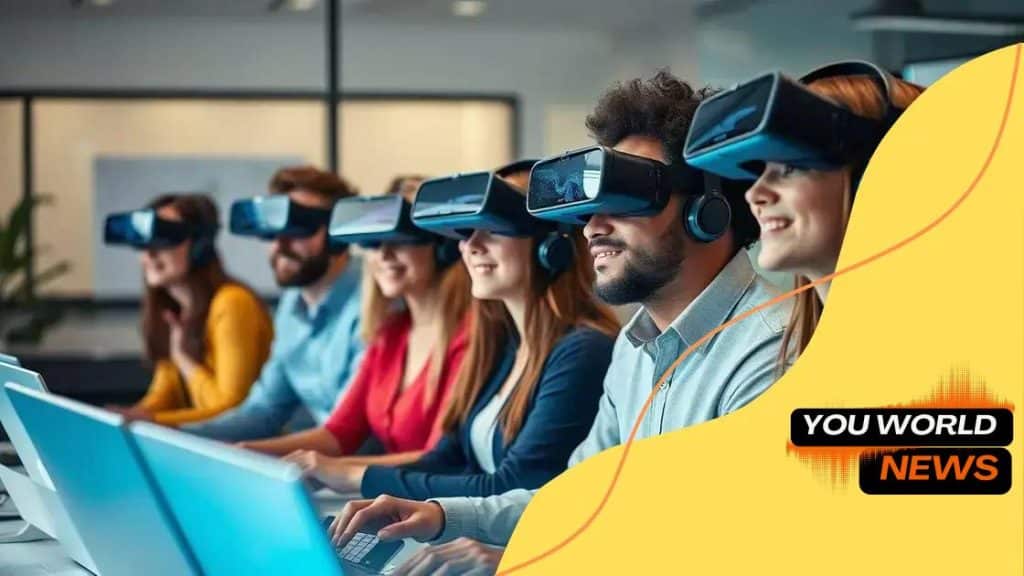How augmented reality is enhancing remote collaboration

Augmented reality is enhancing remote collaboration by enabling teams to visualize projects, improve engagement, and facilitate real-time communication, ultimately increasing productivity and fostering innovative solutions.
How augmented reality is enhancing remote collaboration is a fascinating development. Imagine connecting with teammates from around the world as if they were right next to you. Intrigued? Let’s dive into this transformative technology.
Understanding augmented reality in remote work
Understanding augmented reality in remote work begins with acknowledging its potential to bridge distances between team members. As more organizations adopt remote work, technology is evolving to enhance collaboration, making it more interactive and effective.
What is Augmented Reality?
Augmented reality (AR) overlays digital information on the real world, enhancing our perception of our environment. By using AR tools, remote teams can interact with 3D models, share visual information, and collaborate in real-time, all from different locations.
Benefits of Augmented Reality in Remote Work
Integrating AR into remote work systems brings numerous advantages:
- Enhanced Engagement: AR captivates users, increasing their focus and participation.
- Improved Collaboration: Team members can visualize complex tasks, making it easier to work together on projects.
- Real-Time Solutions: Quick access to visual information allows teams to solve problems immediately, reducing delays.
These benefits make augmented reality a powerful tool in modern workplaces. For instance, through AR, engineers can work on a product’s design while collaborating with colleagues in different locations, seeing the same model overlaid in their physical space.
Another interesting use case is virtual training. With AR, new employees can step into a simulated environment, practicing their roles as if they were on-site. This practical application of AR boosts confidence and prepares them for real-world scenarios.
Moreover, AR fosters innovation. When remote teams use augmented reality, they can visualize goals and ideas in ways that traditional methods cannot provide. This visualization inspires creativity and allows for more robust brainstorming.
As we navigate this shift towards more virtual interactions, understanding augmented reality helps us harness its full potential. By embracing these technologies, teams can remain connected and productive, regardless of their geographical distances.
Key benefits of augmented reality for teams
The key benefits of augmented reality for teams are transforming the way we work together. With this innovative technology, teams experience improved collaboration, communication, and productivity.
Improved Visualization
Augmented reality enhances the visualization of ideas and projects. Team members can see 3D models and interactive elements, allowing for a more comprehensive understanding of complex tasks. This capability helps teams align on goals and foster creativity.
Increased Engagement
AR creates engaging experiences. When teams use augmented reality, they stay focused and interested. This heightened engagement leads to better participation during meetings and training sessions.
- Interactive presentations that capture attention.
- Hands-on practice in a virtual environment.
- Real-time feedback that enhances learning.
The use of AR in training is particularly significant. Employees can practice tasks in a simulated setting, making them more confident and prepared for real-life scenarios.
Enhanced Collaboration
Collaboration is more effective with augmented reality. When teams work on shared projects, AR allows all members to see and interact with the same digital content. This feature leads to seamless communication, even when team members are miles apart.
Especially in design and engineering, teams can collaborate in real-time, making immediate adjustments based on group feedback. This faster decision-making process can significantly reduce project timelines and improve outcomes.
Moreover, augmented reality can help teams identify and solve problems more quickly. By visualizing issues in a 3D format, members can brainstorm solutions together as if they were physically present.
As we continue to explore the evolving landscape of remote work, the advantages of augmented reality for teams become increasingly clear. This technology not only enhances productivity but also fosters a culture of innovation and teamwork.
Tools and technologies for AR collaboration

Tools and technologies for AR collaboration are essential in today’s workplace. They provide teams with the resources needed to work together effectively, no matter where they are located.
Popular AR Collaboration Tools
Many tools offer powerful features for teams. These technologies enable users to create, share, and interact with augmented reality content seamlessly.
- Microsoft HoloLens: A leading AR headset that combines digital content with the real world, allowing team members to collaborate in a shared space.
- Google ARCore: A development platform that enables AR experiences on Android devices, facilitating team interactions on mobile.
- Unity: A game development platform that helps create immersive AR applications, perfect for team projects.
With these tools, teams can visualize designs, conduct training sessions, and run simulations together, enhancing the quality of their collaboration.
Platforms Enabling Augmented Reality
Augmented reality requires robust platforms to run smoothly. Numerous platforms cater to these needs:
- ZapWorks: An AR creation platform that allows users to build interactive content without extensive coding knowledge.
- Blippar: A platform that provides AR experiences for marketing, education, and product development.
- Vuforia: A widely used AR development platform that supports image recognition and tracking, making it easier to create engaging experiences.
These platforms enhance teamwork by allowing each member to contribute unique ideas and insights.
As the field of augmented reality expands, the tools and technologies available will continue to grow. Teams that embrace these advancements can improve their workflows and foster a collaborative environment. By integrating AR tools, team members can interact in ways that were previously unimaginable, making work more efficient and fun.
Real-world examples of AR in action
Real-world examples of AR in action highlight how companies are using this technology to improve their operations. Across various industries, augmented reality is transforming the way teams collaborate and deliver results.
Manufacturing and Design
Many manufacturing companies are using augmented reality to streamline design processes. For instance, automotive manufacturers use AR to visualize car parts before production. This approach helps identify potential issues early, saving time and money. Additionally, workers can use AR glasses to overlay assembly instructions directly onto machinery, making the assembly process more efficient.
- Real-time feedback during production.
- Enhanced training for new employees.
- Improved quality control through visualization.
These applications demonstrate how AR enhances precision and efficiency in manufacturing environments.
Healthcare Innovations
In healthcare, augmented reality provides doctors with better tools for diagnosis and treatment. Surgeons can use AR to overlay critical information during procedures, increasing accuracy. For example, AR can display the location of tumors or blood vessels during surgery.
Moreover, medical training benefits from augmented reality. Students can practice surgical techniques in a safe environment, honing their skills with interactive simulations. This method bridges the gap between theoretical knowledge and practical application.
Education and Training
Augmented reality has also found its place in the education sector. Teachers use AR to create immersive learning experiences that engage students. By integrating AR into lessons, students can explore complex subjects in a hands-on way.
For example, history lessons can include AR experiences where students see historical events unfold before their eyes. Science classes might allow students to interact with virtual molecules or ecosystems.
These real-world examples showcase the versatility of augmented reality across various fields, highlighting its role in enhancing collaboration, training, and overall productivity.
Challenges and considerations in AR adoption
Challenges and considerations in AR adoption are critical for organizations looking to integrate this technology. While augmented reality offers many benefits, it also comes with its own set of hurdles that must be addressed for successful implementation.
Cost of Implementation
The initial costs of adopting AR can be high. Companies need to invest in hardware, software, and training for employees. This can be daunting for smaller organizations. Budgeting for these expenses is crucial to ensure that the investment leads to long-term benefits.
Technical Challenges
Another major concern is the technical challenges associated with AR. Not all systems can support augmented reality applications effectively. Companies must ensure that their infrastructure can handle the increased demand for data processing and connectivity. Additionally, software compatibility can pose issues during the integration phase.
- Ensuring adequate bandwidth for AR applications.
- Maintaining updated hardware to support new features.
- Addressing compatibility issues between various systems.
These technical hurdles can slow down the adoption process and require dedicated IT resources to manage.
User Acceptance
User acceptance is a significant factor in the success of AR adoption. Employees may be hesitant to embrace new technologies. Training programs should be designed to educate staff about the benefits and ease of use of AR tools. Encouraging feedback and addressing concerns can help increase user buy-in.
Furthermore, organizations need to consider the potential impact on workflow. Integrating augmented reality tools should enhance productivity, not disrupt daily operations. A gradual implementation approach can help smooth the transition.
Overall, understanding the challenges and considerations in AR adoption is essential for organizations. By proactively addressing these issues, companies can improve their chances of successfully integrating augmented reality into their operations, maximizing its benefits for collaboration and efficiency.
FAQ – Frequently Asked Questions about Augmented Reality in Remote Collaboration
What are the main benefits of using augmented reality in remote work?
Augmented reality enhances collaboration, improves engagement, and provides better visualization for remote teams, making communication more effective.
What challenges do companies face when adopting AR technology?
Challenges include high implementation costs, technical issues with infrastructure, and user acceptance, which requires training and support.
How can augmented reality improve training in the workplace?
AR allows employees to practice skills in a safe simulated environment, improving their confidence and proficiency before applying skills in real situations.
What tools are commonly used for AR collaboration?
Popular AR tools include Microsoft HoloLens, Google ARCore, and Vuforia, which facilitate interactive experiences and enhance teamwork.





